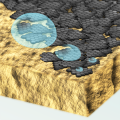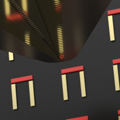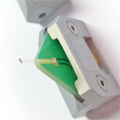
Near-field Microprobes Unlock Next-Gen Semiconductor Inspection with Terahertz Waves
- Details
New in-line metrology technique, powered by advanced THz near-field probes, offers faster, more accurate defect detection during chip manufacturing inside a semiconductor fab.
In a groundbreaking achievement for semiconductor manufacturing, researchers at Samsung Electronics, utilizing key technology from Protemics GmbH, have demonstrated the first-ever use of near-field terahertz (THz) time-domain spectroscopy (TDS) for in-line inspection within a semiconductor fab environment. This milestone, detailed in a recent Nature Communications Engineering article, promises to dramatically improve the speed and accuracy of identifying electrical defects during the critical integration processes of memory chip production.
Read more: Near-field Microprobes Unlock Next-Gen Semiconductor Inspection with Terahertz Waves

Pulling the Terahertz "strings" for label-free molecular fingerprint detection
- Details
Introduction
Biomolecular sensing is an extremely attractive area for terahertz technology, since many characteristic spectral features of biomolecules can be found in the THz frequency range which offer the fundamental possibility of label-free biomolecule detection. However, the large amount of (identical) sample material which is needed for a sufficient contrast - if usual diffraction-limited (far-field) spectroscopy approaches are used - has been identified as a major problem very early [Brucherseifer et al. 2000].
Read more: Pulling the Terahertz "strings" for label-free molecular fingerprint detection

A new way to see - the motion of chiral fermions
- Details
In a recent article entitled "Real-space imaging and control of chiral anomaly induced current at room temperature in topological Dirac semimetal" published in the journal Science Advances B.C. Park et al. from the Sungkyunkwan University and collaborating partners have reported a world-first success in resolving the spatio-temporal motion of chiral fermions with a direct measurement.

TeraCube M2-R scanner system for chip integrity testing
- Details
Ensuring chip integrity is an increasingly important topic with global reach. The Florida Institute for Cybersecurity Research at the University of Florida has been working in this field for many years and is a pioneer in the development of new test methods for the detection of security-relevant modifications in e.g IC's or chip-packages. Among their latest tools for chip integrity testing, a TeraCube M2-R system was recently installed and commissioned.
Read more: TeraCube M2-R scanner system for chip integrity testing

High-resolution THz imaging of plants reaches the cellular level for in-situ analysis
- Details
The TeraSpike near-field microprobe series has been applied in the past for the investigation of organic tissue samples. It is known that the THz frequency range is very usefull for biological and medical applications because of its high sensitivity to water-contents and its spectral sensitivity to selective biomolecule absorbtion lines. Thanks to the sub-wavelength spatial resolution provided by our microprobe sensors even cellular details have been made visible in different studies.
Read more: High-resolution THz imaging of plants reaches the cellular level for in-situ analysis

Graphene-based flexible electronics are taking advantage of TeraSpike microprobes
- Details
Graphene is widely regarded as a promising material for the fabrication of flexible electronic. Inks or dispersions of Graphene can be deposited on flexible substrates by large-scale coating techniques, such as inkjet printing and spray coating. However, inhomogeneity of the obtained conduction layers is one of the main issues developers are currently facing.
Read more: Graphene-based flexible electronics are taking advantage of TeraSpike microprobes

Dutch researches demonstrate TeraSpike at optically excited semiconductors
- Details
One of the most important applications of the TeraSpike probe lies in the field of wafer analysis. So far, it has been mainly used to probe wafer material properties such as sheet resistance or charge carrier mobility under normal ambient conditions. Now a team of researchers from the Dutch institutes DIFFER and Eindhoven University of Technology succeeded in demonstrating the use of the TeraSpike near-field probe for measurements of wafer conductivity under short pulse optical excitation.
Read more: Dutch researches demonstrate TeraSpike at optically excited semiconductors

Laser Focus World features Terahertz Microprobe-based Inspection
- Details
This months issue of the Laser Focus World Magazine is featuring an article about Protemics THz microprobe technology applied to different inspection applications. The operation of the TeraCube near-field imaging system with a modern fiber-based time-domain spectroscopy module is also highlighted.
Read more: Laser Focus World features Terahertz Microprobe-based Inspection

Advanced THz Metamaterials - Caught in the act
- Details
Researchers from the Dutch institute DIFFER, Eindhoven, demonstrate an elegant way to enhance electro-magnetically induced transparency in meta-materials without being constraint by the resolution limitations of fabrication tools. While earlier methods relied on

Product news: All electronic Schottky-diode-based near-field probe series GigaSpike
- Details
We proudly present our first all-electronic field probe device series called "GigaSpike" enabling fast and cost-efficient measurements of sub-THz and millimeter-wave range electric field amplitudes. The new active GigaSpike probes are based on zero-bias Schottky diodes
Read more: Product news: All electronic Schottky-diode-based near-field probe series GigaSpike

Customer survey: Prize winner
- Details
We would like to thank all the participants of our recent Terahertz technology survey. The lucky winner of the Lenovo Miix 310 convertible PC who has been drawn by our lottery volunteer is Mrs. Jannika Lauth from TU Delft.
Congratulations!

Product news: First near-field probe for reflection-mode measurements
- Details
So far, microprobes from the TeraSpike product series have been solely designed for THz detection or generation purposes. The new TeraSpike probe TD-800-TR.5 comes with a pair of closely spaced photoconductive THz antennas. While one antenna is used as a THz pulse generator, the other antenna works as the detector.
Read more: Product news: First near-field probe for reflection-mode measurements

Product news: Ready for 1550nm fiber lasers
- Details
Protemics is offering an easy to operate optical interface enabling the use of cost-efficient femtosecond fiber lasers (working in the telecom wavelength range) as powerful sources for the excitation of LT-GaAs-based TeraSpike microprobes and TeraBlast bias-free THz emitters.


Terahertz waves beware - it´s a trap!
- Details
Protemics has developed a new electrode design* called “wavetrap” which is effectively avoiding any unwanted probe-internal transmission of guided Terahertz waves and visible parasitic reflections in a recorded time-domain signal.

Research study underlines the importance of near-field measurements
- Details
An effect which is principally known but hard to measure so far has now been quantified by a Dutch research group led by Prof. Jaime Gomez Rivas (AMOLF, Amsterdam): Resonant structures exposed to light may oscillate at a much slower speed than implied by standard spectroscopic measurements.
Read more: Research study underlines the importance of near-field measurements

A NEW WAY TO SEE - the hidden potential for PV solar cell optimization
- Details
Petten/Aachen – Today, the worldwide first automated wafer analysis system based on Protemics´ proprietary THz microprobe technology has been successfully launched at the Energy research Centre of the Netherlands (ECN) for the advanced analysis of high tech solar cells.
Read more: A NEW WAY TO SEE - the hidden potential for PV solar cell optimization

Protemics successfully taking-off in Hong Kong
- Details
Hong Kong – At the end of this year's IRMMW-THz conference and exhibition in Hong Kong, the team of Protemics just let it fly. The world´s biggest and oldest THz-related conference series – the International Conference on Infrared, Millimeter and Terahertz Waves – has been the perfect place for a successful launch of the new TeraSpike XR microprobe and a fantastic opportunity to get in contact with Terahertz experts from around the world.

Protemics and ECN join forces on Terahertz analytics for photovoltaic applications
- Details
Aachen/Petten – Non-destructive testing is one of the most important applications of recent technological developments operating in the spectral range of Terahertz (THz) frequencies. For example, THz radiation is able to unveil sheet resistance distributions and charge carrier dynamics in semiconductors or thin-film conductors also under difficult situations such as on rough or passivated surfaces.
Read more: Protemics and ECN join forces on Terahertz analytics for photovoltaic applications

TeraCube Scientific - New THz near-field scanning system launched
- Details
The product portfolio of Protemics has been substantially extended. With the TeraCube Scientific now a full featured automated system platform for high-resolution Terahertz near-field imaging is offered in addition to our set of application specific THz microprobe and emitter components.
Read more: TeraCube Scientific - New THz near-field scanning system launched
Cooperation on anti-counterfeiting technology
- Details
Aachen/Pleasanton - Rolith, Inc. has developed a new type of security labels which are invisible to the human eye and standard equipment but can be read-out by Terahertz microprobe sensors from Protemics. Both companies are now cooperating on the development of custom-specific end-user solutions.
THz emitter product launched
- Details

TeraBlast - The new bias-free large-area Terahertz emitter is now available from Protemics. Get the most out of your THz time-domain spectroscopy and near-field system with this highly effcient and easy to handle THz source. Find more information on our product page.
LaserFocusWorld reports on TeraSpike application
- Details

TeraSpike microprobes from Protemics are highlighted in the May issue of LaserFocusWorld as novel non-destructive testing tool: As demonstrated in a recent study undertaken by Protemics GmbH and the Fraunhofer ILT (Aachen) the non-destructive detection of micron-scale air voids
BMWi-support granted
- Details

The start-up team Protemics will be financially supported from the Federal Ministry of Economics and Technology and the European Social Fund, ESF in the second project-phase of the currently running "EXIST-Forschungstransfer" project.